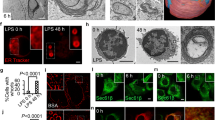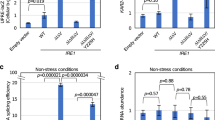Abstract
Protein synthesis and the folding of the newly synthesized proteins into the correct three-dimensional structure are coupled in cellular compartments of the exocytosis pathway by a process that modulates the phosphorylation level of eukaryotic initiation factor-2α (eIF2α) in response to a stress signal from the endoplasmic reticulum (ER)1,2. Activation of this process leads to reduced rates of initiation of protein translation during ER stress3. Here we describe the cloning of perk, a gene encoding a type I transmembrane ER-resident protein. PERK has a lumenal domain that is similar to the ER-stress-sensing lumenal domain of the ER-resident kinase Ire1, and a cytoplasmic portion that contains a protein-kinase domain most similar to that of the known eIF2α kinases, PKR and HRI. ER stress increases PERK's protein-kinase activity and PERK phosphorylates eIF2α on serine residue 51, inhibiting translation of messenger RNA into protein. These properties implicate PERK in a signalling pathway that attenuates protein translation in response to ER stress.
This is a preview of subscription content, access via your institution
Access options
Subscribe to this journal
Receive 51 print issues and online access
$199.00 per year
only $3.90 per issue
Buy this article
- Purchase on SpringerLink
- Instant access to full article PDF
Prices may be subject to local taxes which are calculated during checkout



Similar content being viewed by others
References
Prostko, C. R., Brostrom, M. A. & Brostrom, C. O. Reversible phosphorylation of eukaryotic initiation factor 2 alpha in response to endoplasmic reticular signaling. Mol. Cell Biochem. 127–128;, 255–265 (1993).
Brostrom, C. O. & Brostrom, M. A. Regulation of translational initiation during cellular response to stress. Prog. Nucleic Acid Res. Mol. Biol. 58, 79–125 (1998).
Wong, W. L., Brostrom, M. A., Kuznetsov, G., Gmitter-Yellen, D. & Brostrom, C. O. Inhibition of protein synthesis and early protein processing by thapsigargin in cultured cells. Biochem. J. 289, 71–79 (1993).
Lee, A. Mammalian stress response: induction of the glucose-regulated protein family. Curr. Biol. 4, 267–273 (1993).
Kozutsumi, Y., Segal, M., Normington, K., Gething, M. J. & Sambrook, J. The presence of malfolded proteins in the endoplasmic reticulum signals the induction of glucose-regulated proteins. Nature 332, 462–464 (1988).
Gething, M. J. & Sambrook, J. Protein folding in the cell. Nature 355, 33–45 (1992).
Cox, J. S., Shamu, C. E. & Walter, P. Transcriptional induction of genes encoding endoplasmic reticulum resident proteins requires a transmembrane protein kinase. Cell 73, 1197–1206 (1993).
Mori, K., Ma, W., Gething, M. J. & Sambrook, J. Atransmembrane protein with a cdc2+/CDC28-related kinase activity is required for signaling from the ER to the nucleus. Cell 74, 743–756 (1993).
Tirasophon, W., Welihinda, A. A. & Kaufman, R. J. Astress response pathway from the endoplasmic reticulum ot the nucleus requires a novel bifunctional protein kinase/endoribonuclease (Ire1p) in mammalian cells. Genes Dev. 12, 1812–1824 (1998).
Wang, X. -Z. et al. Cloning of mammalian Ire1 reveals diversity in the ER stress responses. EMBO J. 19, 5708–5717 (1998).
Shamu, C. E. Splicing together the unfolded-protein response. Curr. Biol. 7, R67–R70 (1997).
Hinnebusch, A. G. The eIF-2 alpha kinases: regulators of protein synthesis in starvation and stress. Semin. Cell Biol. 5, 417–426 (1994).
Srivastava, S. P., Davies, M. V. & Kaufman, R. J. Calcium depletion from the endoplasmic reticulum activates the double-stranded RNA-dependent protein kinase (PKR) to inhibit protein synthesis. J. Biol. Chem. 270, 16619–16624 (1995).
Chen, J. J. & London, I. M. Regulation of protein synthesis by heme-regulated eIF-2 alpha kinase. Trends Biochem. Sci. 20, 105–108 (1995).
Berry, M. J., Knutson, G. S., Lasky, S. R., Munemitsu, S. M. & Samuel, C. E. Mechanism of interferon action. Purification and substrate specificities of the double-stranded RNA-dependent protein kinase from untreated and interferon-treated mouse fibroblasts. J. Biol. Chem. 260, 11240–11247 (1985).
Prostko, C. R., Dholakia, J. N., Brostrom, M. A. & Brostrom, C. O. Activation of the double-stranded RNA-regulated protein kinase by depletion of endoplasmic reticular calcium stores. J. Biol. Chem. 270, 6211–6215 (1995).
Fagard, R. & London, I. M. Relationship between phosphorylation and activity of heme-regulated eukaryotic initiation factor 2 alpha kinase. Proc. Natl Acad. Sci. USA 78, 866–870 (1981).
Wang, X. -Z. et al. Signals for the stressed endoplasmic reticulum induce C/EBP homologous protein (CHOP/GADD153). Mol. Cell. Biol. 16, 4273–4280 (1996).
Price, B. & Calderwood, S. Gadd45 and Gadd153 messenger RNA levels are increased during hypoxia and after exposure of cells to agents which elevate the levels of glucose-regulated proteins. Cancer Res. 52, 3814–3817 (1992).
Brostrom, M. A., Prostko, C. R., Gmitter, D. & Brostrom, C. O. Independent signaling of grp78 gene transcription and phosphorylation of eukaryotic initiator factor 2 alpha by the stressed endoplasmic reticulum. J. Biol. Chem. 270, 4127–4132 (1995).
Shamu, C. E. & Walter, P. Oligomerization and phosphorylation of the Ire1p kinase during intracellular signaling from the endoplasmic reticulum ot the nucleus. EMBO J. 15, 3028–3039 (1996).
Welihinda, A. A. & Kaufman, R. J. The unfolded protein response pathway in Saccharomyces cerevisiae. Oligomerization and trans-phosphorylation of Ire1p (Ern1p) are required for kinase activation. J. Biol. Chem. 271, 18181–18187 (1996).
Sidrauski, C. & Walter, P. The transmembrane kinase Ire1p is a site-specific endonuclease that initiates mRNA splicing in the unfolded protein response. Cell 90, 1031–1039 (1997).
Wu, S. & Kaufman, R. J. Amodel for the double-stranded RNA (dsRNA)-dependent dimerization and activation of the dsRNA-activated protein kinase PKR. J. Biol. Chem. 272, 1291–1296 (1997).
Savinova, O. & Jagus, R. Use of vertical slab isoelectric focusing and immunoblotting to evaluate steady-state phosphorylation of eIF2 alpha in cultured cells. Methods 11, 419–425 (1997).
Shi, Y. et al. Identification and characterization of pancreatic eukaryotic initiation factor 2 alpha-subunit kinase, PEK, involved in translational control. Mol. Cell. Biol. 18, 7499–7509 (1998).
Acknowledgements
We thank R. Schneider for the eIF2α expression plasmids, antisera and purified protein; M. Green for the immunoglobulin µ-chain expression plasmid; B. Williams for the pkr−/− cells; G.Kreibich for the antisera against ribophorin; and X.-Z. Wang for the cDNA libary. This work was supported by NIH grants and an NIH training grant (to H.P.H.). D.R. is a Stephen Birnbaum Scholar of the Leukemia Society of America.
Author information
Authors and Affiliations
Corresponding author
Rights and permissions
About this article
Cite this article
Harding, H., Zhang, Y. & Ron, D. Protein translation and folding are coupled by an endoplasmic-reticulum-resident kinase. Nature 397, 271–274 (1999). https://doi.org/10.1038/16729
Received:
Accepted:
Issue Date:
DOI: https://doi.org/10.1038/16729



